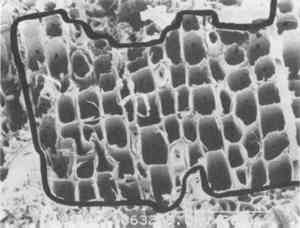CONSOLIDANT DISTRIBUTION IN DETERIORATED WOOD TREATED WITH SOLUBLE RESINSARNO P. SCHNIEWIND, & PETER Y. EASTMAN
2 MATERIALS AND METHODSThe material for the present study was taken from matchstick-size specimens that had previously been treated with consolidants by vacuum impregnation and then subjected to static bending tests in a study of consolidant effectiveness (Wang and Schniewind 1985). The material was taken from the outer layers of Douglas fir foundation piles that had been in the ground for approximately 70 years and had In addition, three specimens treated with 20 wt% solution of Butvar B90, two in a 40/60 mixture of ethanol and toluene (90.ET.H) and one in ethanol (90E.H), were examined. Finally, one specimen treated with a 5 wt% solution of Butvar B98 in a 40/60 mixture of ethanol and toluene (98ET.L) was included in the study. The specimens were examined in a Hitachi S-2300 scanning electron microscope (SEM). Initially both cross sections and split radial sections were to be examined, but it was found much more difficult to locate consolidant resin in the radial sections. Accordingly, the examination was confined to cross sections. It was found that the brash fractures that occurred during the previous static bending tests made excellent surfaces for examination. These fractures had taken place at approximately midlength of the 3 � 3 � 50 mm bending specimens. Since wood is known to be more permeable along than across the grain, it wassuspected that a substantial amount of drying would take place from the end surfaces, possibly leading to differences in the longitudinal distribution of consolidant. To study this possibility, closely spaced serial sections were desired. It was found that by using specially constructed clamping devices that held all four sides of the 3 � 3 mm sticks, one half-length of bending specimen could reliably be broken into six pieces, each approximately 3.5 mm in length. Brash fractures were encouraged by drying the specimens in a desiccator and scoring the tension and the two side surfaces with a razor blade to a depth of 1 to 5 cell diameters at the desired fracture section. The 3.5 mm lengths were smoothed at one end to obtain a level contact surface. They were mounted on an SEM specimen stub with colloidal carbon. The samples were then dried and sputter coated with gold. They were viewed in the SEM with an accelerating voltage of 8 to 15 kV at various magnifications. Systematic measurements were made on prints taken at a magnification of 200� of an area of earlywood as close as possible to the center of the cross section (core position) and another area close to the surface (edge position) and within the same growth ring. Occasionally the area near the surface had to be selected from an adjacent growth ring. The examination was confined to earlywood, because the latewood tracheids were too seriously degraded and distorted for analysis. On each of the prints used for analysis, a sample area of earlywood was marked out. Depending on ring width, cell size, and image clarity, this area contained from 30 to 139 tracheids, the average being 85. The number of tracheids containing solid plugs of resin in the lumen and those that had a thick lining or sleeve or resin in the lumen were counted and expressed as a percentage of the total number of tracheids in the sample area. An example of such a marked sample area is shown in figure 1.
Although plugs and sleeves of resin were counted separately, the combined percentage of all tracheids containing obvious amounts of resin was used for analysis. Statistical analysis was carried out using Statgraphics software and a personal computer. |
